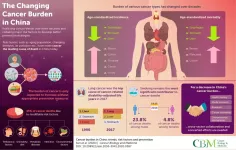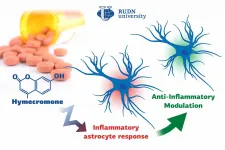(Press-News.org) The past century or so has seen unprecedented technological, scientific, and sociological evolution worldwide. These have accompanied global shifts in people's lifestyles and rapid changes in the environment, both natural and man-made. An unfavorable consequence of these alterations has been the increasing burden of cancer on human society.
As the country with the largest population, China has borne this burden heavily. Despite the massive progress China has made in healthcare since the 1950s, cancer has become the leading killer in the country. In 2015, nearly 2.4 million lives were taken by this disease. Cancer lies latent for years before it manifests; so perhaps, its burden will only continue to grow in the coming decades.
But when you break down these statistics by type of cancer and risk factor, what do the salient trends look like? A group of researchers reviewed data from various national mortality surveys, cancer registries, and online databases to find out.
Speaking of their motivations to conduct the review, lead researcher Dr. Wanqing Chen, Director of the Office of Cancer Screening, National Cancer Center/National Clinical Research Center for Cancer/Cancer Hospital, China, says: "This review could provide scientists and policy-makers with a tool to find what works, what matters, and what is expected." The paper is published Open Access in Cancer Biology & Medicine.
The team's perusal of 22 Chinese registries revealed an increase in the cancer incidence from 2000 to 2011, with the increase being largely attributable to increased incidences of colorectal, prostate, breast, cervical, and ovarian cancers. Interestingly, the incidences of liver, esophageal, and stomach cancers reduced significantly. This could be because of the widespread hepatitis B vaccination across the country during this period in addition to an overall improvement in food preservation practices and living conditions.
Cancer mortality data from 1990 to 2015 mirrored the incidence data with rising mortality rates seen in the cases of colorectal, pancreatic, and breast cancers and falling rates seen in stomach, esophageal, and liver cancers. Yet, though the burden of these upper gastrointestinal cancers has fallen significantly, it still hangs heavy.
Between 1990 and 2017, lung cancer climbed to the top of the list of different types of cancers responsible for years of healthy life lost to illness, disability, or death (disability-adjusted life years, DALYs). Liver and stomach cancers were second and third in line.
Sadly, further research suggests that quite a large chunk of these cases and deaths could, perhaps, have been prevented. Data from the National Cancer Center, China, attributes 45% of cancer deaths in the country to modifiable risk factors--behavioral, clinical, or environmental. For instance, 23.8% of cancer deaths among men and 4.8% among women in 2014 are attributed to smoking. From 1990 to 2017, cancer deaths caused by smoking increased by over 150%. Given that China currently consumes about 40% of the world's tobacco, if habits don't change, the future looks grave.
Apart from smoking, physical inactivity, an unhealthy diet, and heavy alcohol consumption are major contributing behavioral risk factors for cancer; diabetes, obesity, and infectious diseases are prominent clinical risk factors; and air pollution, as well as occupational exposure to carcinogenic compounds such as soot, asbestos, and silica, are important environmental risk factors.
However, even in these seemingly dark times there is a spot of light. Technological advancement coupled with good healthcare and insurance policies and a growing general awareness among the people have, perhaps, contributed to the improvement in cancer survival rates seen between 2003 and 2015.
Still, prevention remains better than cure. As Dr. Chen explains: ''Taking all this critical information together, one can see that implementing cost-effective approaches for primary prevention is of utmost importance. Our paper highlights the requirement for collaborative efforts by the government, public health organizations, and the people to reduce the cancer burden in the country. We hope that our work can inform policies such as Healthy China 2030."
Perhaps the successful implementation of policies based on such research in China and worldwide can lift the burden of cancer from the world's shoulders.
INFORMATION:
Reference
Authors: Dianqin Sun (1), He Li (1), Maomao Cao (1), Siyi He (1), Lin Lei (2), Ji Peng (2), Wanqing Chen (1)
Title of original paper: Cancer burden in China: trends, risk factors and prevention
Journal : Cancer Biology & Medicine
DOI: 10.20892/j.issn.2095-3941.2020.0387
Affiliations:
(1) Department of Cancer Screening, National Cancer Center/National Clinical Research Center for Cancer/Cancer Hospital, Chinese Academy of Medical Sciences and Peking Union Medical College, China
(2) Department of Cancer Prevention and Control, Shenzhen Center for Chronic Disease Control, China
About Dr. Wanqing Chen
Dr. Wanqing Chen is Director of the Office of Cancer Screening, National Cancer Center/National Clinical Research Center for Cancer/Cancer Hospital, China. He is also affiliated to the Chinese Academy of Medical Sciences and Peking Union Medical College, China. Over the course of his career, he has led multiple research programs of national and international interest and undertaken several national key public health projects, including the third national retrospective death survey and program of early diagnosis and treatment of cancer. As an authoritative figure in the field of cancer research, he has published over 300 academic papers as first author or corresponding author; and as chief editor or deputy editor, he has compiled 13 monographs.
Transfer RNAs (tRNAs) deliver specific amino acids to ribosomes during translation of messenger RNA into proteins. The abundance of tRNAs can therefore have a profound impact on cell physiology, but measuring the amount of each tRNA in cells has been limited by technical challenges. Researchers at the Max Planck Institute of Biochemistry have now overcome these limitations with mim-tRNAseq, a method that can be used to quantify tRNAs in any organism and will help improve our understanding of tRNA regulation in health and disease.
A cell contains several hundred thousand tRNA molecules, each of which consists of only 70 to 90 nucleotides folded into a cloverleaf-like pattern. At one end, tRNAs carry one of the twenty amino acids that serve as protein building blocks, while the ...
What The Study Did: Researchers investigated whether home addresses recorded in the electronic medical record could be used to accurately estimate transmission risk of SARS-CoV-2 and identify risk factors for transmission.
Authors: Joshua P. Metlay, M.D., Ph.D., of Massachusetts General Hospital in Boston, is the corresponding author.
To access the embargoed study: Visit our For The Media website at this link https://media.jamanetwork.com/
(doi:10.1001/jamanetworkopen.2021.0304)
Editor's Note: Please see the article for additional information, including other authors, author contributions and affiliations, conflict of interest and financial ...
What The Study Did: Researchers in this observational study assess at what age young people ages 12 to 17 start using cigarettes.
Authors: Adriana Pérez, Ph.D., of the University of Texas Health Science Center at Houston in Austin, is the corresponding author.
To access the embargoed study: Visit our For The Media website at this link https://media.jamanetwork.com/
(doi:10.1001/jamanetworkopen.2021.0218)
Editor's Note: The article includes conflicts of interest and funding/support disclosures. Please see the article for additional information, including other authors, author contributions and affiliations, conflict of interest and financial disclosures, and funding and support.
INFORMATION:
Media advisory: The full study is linked to ...
PHILADELPHIA-- Even though the use of rhythm control strategies for treating Paroxysmal Atrial Fibrillation (AF), a common abnormal heart rhythm, have increased overall in the United States, patients from racial and ethnic minority groups and those with lower income were less likely to receive rhythm control treatment - often the preferred treatment - according to new research from the Perelman School of Medicine at the University of Pennsylvania. The study is published in the JAMA Network Open.
"Research has demonstrated the pervasive impact of structural racism on health outcomes among minoritized patients. We know, for instance, that there is less use of novel cardiovascular therapies among Black, Latinx, and patients of lower socioeconomic ...
A Mason Engineering researcher has discovered that artificial microswimmers accumulate where their speed is minimized, an idea that could have implications for improving the efficacy of targeted cancer therapy.
Jeff Moran, an assistant professor of mechanical engineering in the Volgenau School of Engineering, and colleagues from the University of Washington in Seattle studied self-propelled half-platinum/half-gold rods that "swim" in water using hydrogen peroxide as a fuel. The more peroxide there is, the faster the swimming; without peroxide in pure water, the rods don't swim.
In this work, they set out to understand ...
People living with obesity tend to have unhealthy glucose and lipid levels in their blood, as well as high blood pressure. As a result, they are more at risk of cardiovascular and metabolic diseases. But scientists have observed that up to 45% of people living with obesity have healthy blood pressure and glucose and lipid levels, and therefore may not be at high risk of disease. The reason why this group of people with obesity remain healthy, has been poorly understood.
But now a team of researchers - led by scientists at the University of Copenhagen and Icahn School of Medicine ...
Biologists from RUDN University confirmed that a well-known spasmolytic drug called hymecromone can suppress the inflammatory response in astrocytes, important glial cells of the central nervous system. Potentially, it could be used to develop medications against Alzheimer's disease and other neurodegenerative conditions. The results of the study were published in the International Journal of Molecular Sciences.
All pathological processes in the nervous system, such as neurodegenerative diseases, injuries, or intoxications, are associated with inflammations. ...
An insecticide used to control pest infestations on squash and pumpkins significantly hinders the reproduction of ground-nesting bees -- valuable pollinators for many food crops, a new University of Guelph study has revealed.
This first-ever study of pesticide impacts on a ground-nesting bee in a real-world context found female hoary squash bees exposed to imidacloprid dug 85 per cent fewer nests, collected less pollen from crop flowers and produced 89 per cent fewer offspring than unexposed bees.
"Because they're not making nests and not collecting pollen, they cannot raise offspring," said Dr. Susan Willis Chan, a post-doc in the School of ...
Heart problems cause disturbed gene activity in the brain's memory center, from which cognitive deficits arise. Researchers at the German Center for Neurodegenerative Diseases (DZNE), the University Medical Center Göttingen (UMG) and the German Center for Cardiovascular Research (DZHK) come to this conclusion based on laboratory studies. They consider that they have found a possible cause for the increased risk of dementia in people with heart problems. In mice, a specific drug which is known to affect gene activity alleviated the mental deficits. The involved experts see these results as potential approaches for therapies. ...
HOUSTON - (Feb. 26, 2021) - Tracking the origin of synthetic genetic code has never been simple, but it can be done through bioinformatic or, increasingly, deep learning computational approaches.
Though the latter gets the lion's share of attention, new research by computer scientist Todd Treangen of Rice University's Brown School of Engineering is focused on whether sequence alignment and pan-genome-based methods can outperform recent deep learning approaches in this area.
"This is, in a sense, against the grain given that deep learning approaches have recently outperformed traditional approaches, such as BLAST," he said. "My goal with this study is to start a conversation about how to combine the expertise of both domains to achieve further improvements for this important computational ...




